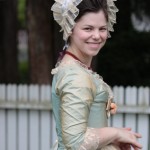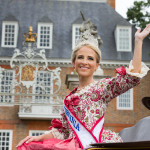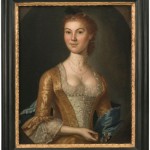When Janea Whitacre’s family moved to Virginia when she was 9, one of the first places they visited was Colonial Williamsburg’s Historic Area. She vividly recalls a yellow print gingham dress worn by a female interpreter that seemed a touch too tight in the bodice. She loved clothes even at that age, and told her parents then and there that she would one day work among the tradesmen and tradeswomen she saw in the Historic Area.
A fascination that began at age 4, when her sister Robin taught her to sew, became a lifelong passion. Today, after more than three decades as Colonial Williamsburg’s milliner and mantua maker, she says this is still the place she wants to work.
“I really wanted to understand the people who made the clothes,” says Whitacre. “I wanted to read the same newspapers they would have read and the same books. I wanted to know as much about the thinking of these people as I could.”
She began preparing in college. She studied art history at Old Dominion University in Norfolk, and especially loved 18th-century medieval architecture, in addition to the clothing from that period.
It’s not surprising that she was more interested in the clothes worn in the paintings than other aspects such as style or technique.
“Art history is a wonderful platform for the history of clothing,” she says. She explored the reasons people wore the clothing that they did – connecting clothing to society, politics, economics and more. “In art history you have to understand all that when you look at a painting and I started applying that kind of methodology to clothes.”
Whitacre, working with an apprentice, makes a variety of clothing, hand-sewn the same way it would have been in the late 1700s. These include dresses and undergarments, as well as accessories such as cloaks and bonnets. A mantua, for example, is a type of gown worn in the late 17th and 18th centuries with a stomacher – a triangular pattern that fits on the bodice of a woman’s gown — and petticoat.
The shop, which in 2014 celebrated its 60th year, shares space and scheduling with the tailor’s staff, and the trades participate in some programs together. The tailor’s trade was the largest trade in the city in the late 18th century.
Early Milliners
Little is known about the18th-century Williamsburg milliner Whitacre sometimes portrays. There are a few clues to the lives of 18th-century milliners, mostly found in newspaper articles and advertisements, a few court records and some letters, and Whitacre admits that “we wish we knew more.” What is known is that Margaret Hunter did well enough to contribute financially to the colonists in support of the revolution.
Millinery was one of the few trades dominated by women, and would have afforded a woman like Hunter the means to support herself and be independent, according to Whitacre. Hunter apparently never married or had children.
“Fashion was an incredible motivation of the economy of that time and there was the potential for extreme profit,” she says. Hunter would have been competing against other shops in the area selling imported millinery items.
But she would have provided custom services and garments. She would have also mended clothing and fitted used garments to be passed on to another wearer. Clothes were not just discarded, but used over and over until there was no more use left in them.
Today, Whitacre, her apprentices and volunteers wear the clothing they make in the shop and some of the items are also on display. They also make items needed for special programs, for the Art Museums of Colonial Williamsburg as well as for other museums, and – as time permits – a few custom orders.
Evolution of a Shop
During her time in the Historic Area, Whitacre has seen the shop evolve into a fully interpretive trade shop.
When she first worked at the shop in the summer of 1982, the shop was producing few accessories and there was very little that visitors could handle. The shop displayed clothing items under glass so “you could point to things,” she explains.
Freshly graduated from college, Whitacre had taken a temporary 13-week summer position. By fall, she had an opportunity — work three days spinning and weaving, and two days at the milliner’s shop.
“I decided that I didn’t know what I wanted to do, but was having a lot of fun. Going on 33 years later, I’m still having fun,” she says.
“I was extremely fortunate and lucky that it turned out that I could stay,” she says, because the initiative to develop the trade started in 1984-85, and she played a part in this decade-long process which involved extensive research.
Since there wasn’t much information on a milliner from 18th-century Virginia, Whitacre says she researched other milliners in the U.S. South, finding references to a milliner in South Carolina, which she relied on heavily. The research was slow and time-consuming in those days. In the days before Google, the searches were on microfiche and microfilm.
From the records that were located, it was determined that milliners up and down the East Coast were advertising and selling the same sorts of items during the 18th century, she says.
Becoming an Interpretive Trade
In order to qualify as a trade, you had to basically prove that the trade had an apprenticeship in the Colonial era, says Whitacre. That’s one reason mantua making is integrated in the millinery shop today. There were Colonial records of a mantua-making apprentice, but none of a milliner’s apprentice.
In 1995, the shop debuted three separate interpretive trades – the milliner’s, mantua making and the tailor’s trades – all in one location. Whitacre was the first journeyman for the milliner and mantua making.
She has supervised the shop since 1985, one of only three to lead the shop in its 60-year existence. She began with one apprentice Doris Warren, and today still has one apprentice. A new apprentice Abby Cox is just transitioning into the shop at present, as Sarah Woodyard is winding up her apprenticeship.
Whitacre sometimes teaches workshops around the country – from South Carolina to Tennessee to California – for the Colonial Williamburg Foundation and for other museums and private groups.
She’s also traveled around the country and to Europe for conferences and workshops related to period clothing. A member of the National Board of the Costume Society of America and is completing her term as president of the Southeastern Region of the Costume Society of America. For that organization, she has presented papers on her research and once was asked to speak at the Costume Society in Bath, England on her favorite Williamsburg mantua-maker, Margaret Brodie.
And just like the child who made “a little purse out of scraps from a raincoat” which she took to show-and-tell, Whitacre still sews for pleasure. She makes some of her own clothes, purses and hats, and likes making clothes from other time periods for several local theater groups.
And Colonial Williamsburg has been something of a family affair. The sister who taught her to sew? Robin Kipps now manages the Pasteur and Galt Apothecary in the Historic Area.
Learn more:



[…] extra hands to make the work light. A video of a lilac silk gown being made in a day may be seen here, as well as an article about Mistress Whitacre and eighteenth-century millinery […]